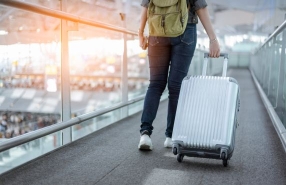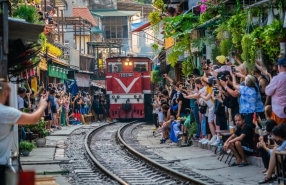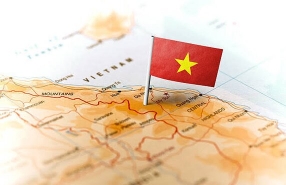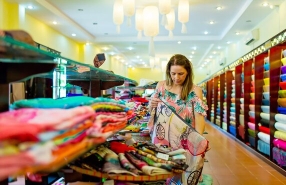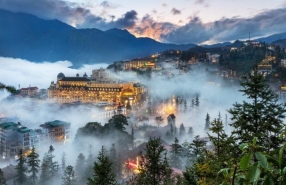Must-visit Hue Tourist Attraction: Thien Mu Pagoda

Looking for ideas on Hue what to do? Don’t miss Thien Mu Pagoda — a must-visit Hue tourist attraction. Perched gracefully on the banks of the Perfume River, this iconic pagoda showcases classic Hue architecture and deep spiritual significance. Built in the 17th century, Thien Mu Pagoda is not only a symbol of the city’s heritage but also a serene spot for cultural discovery. The best time to visit Thien Mu pagoda is in the late afternoon, when you can hear the tranquil chants of monks during prayer and enjoy a breathtaking sunset over the Perfume River. Whether you're on a city tour or exploring on your own, Thien Mu Pagoda is an unmissable highlight for anyone searching Hue what to do.
Visit Thien Mu Pagoda Hue
I. What is Thien Mu Pagoda?
1. Formation and Growth of Thien Mu Pagoda
The exquisite pagoda was constructed around 1601. The pagoda was later repaired by a number of Nguyen Dynasty kings, including Gia Long, Minh Mang, Thieu Tri, and Thanh Thai. Hoang began leading his sovereign kingdom in central Vietnam while serving as the governor of the province of Thuan Hoa, which is now known as Hue. The royal chronicles state that Hoang traveled by the hill that is now home to the Thien Mu Pagoda while on a holiday and sightseeing excursion to reflect on the surrounding seas and mountains. He had the pagoda built after learning about the aforementioned local folklore. The original temple was built in a fairly basic manner, but it has since been enlarged and renovated with more elaborate elements.
2. A Special Architectural Site in Hue
The pagoda's most remarkable feature, Phuoc Duyen tower (formerly known as Tu Nhan tower), was built by King Thieu Tri in 1884 and has since come to represent Hue informally. This seven-story, two-meter-tall, octagonal structure is devoted to a Buddha who manifested as a person. Being the tallest stupa in Vietnam, it is frequently featured in folktales and cadao about Hue due to its legendary reputation and connection to the city. It is also recognized as the unofficial emblem of the previous imperial capital, which is more significant.
A pavilion with a huge bell within is located to the tower's left. In 1710, Lord Nguyen Phuc Chu tossed the bell known as Dai Hong Chung. It is well-known for its enormous size, standing 2.5 meters tall and weighing 3,285 kg. It is regarded as an exceptional example of bronze casting from the eighteenth century.
A 1715 stela can be found in a pavilion to the tower's right. It stands 2.58 meters tall and is perched atop a large marble turtle, a representation of longevity.In addition, the pagoda contains a number of well-known pieces of art that captivate visitors greatly. Take the main hall of the Dai Hung shrine, for example, which has amazing architecture.
3. Historical Role of Thien Mu Pagoda
In addition to its architectural significance, Thien Mu Pagoda has a rich historical background that draws in tourists. Like many other pagodas in South Vietnam, Thien Mu Pagoda saw a surge of anti-government protests in the summer of 1963. Since President Ngo Dinh Diem came to office in 1955, the majority of Buddhists in South Vietnam had been unhappy with his administration for a long time. In the army, in public service, and in the disbursement of government funds, Diem had demonstrated a pronounced bias in favor of Catholics and discrimination against Buddhists. Nine Buddhists were killed by Diem's troops and police on Vesak, the birthday of Gautama Buddha, in the summer of 1963, sparking widespread unrest in Hue.
As a result, Buddhist demonstrations spread throughout the nation and grew larger over time. Back then, the Thien Mu Pagoda served as a central hub for the Buddhist movement and was frequently the site of rallies, hunger strikes, and barricades.
The pagoda is now encircled by decorative plants and flowers. A serene and lovely forest of pine trees extends to the garden's far end. It is quite hospitable to all guests and well-maintained.

II. About Location, opening hours and ticket fee
Location: Thien Mu Pagoda (namely Heaven Fairy Lady Pagoda), also known as Linh Mu Pagoda, is one of the most fascinating and ancient pagoda in Hue city. It is situated on Ha Khe hill, on the north bank of the Perfume River, in Huong Long village, 5 kilometers from Hue city, which is easy to reach from the city center.
Google Map: Thien Mu Pagoda
Entrance fee: Free
Opening hours:
The pagoda is open all day, so you can feel free to visit. However, if you want to take stunning photos and enjoy the peaceful ambiance of the pagoda, 6:00 am - 8:00 am would be the most suitable time frame. Besides, if you want to admire the romantic sunset on the banks of the peaceful Huong River, please be there from 5:00 to 6:00 pm.
III. What to see in Thien Mu Pagoda?
1. Tam Quan Gate
Behind Phuoc Duyen Tower, it is the pagoda's main entrance. The human, the demon, and the god worlds are divided into three roads that lead from the gate. There are eight roofs and two stories in the gate. The middle gate's second story is home to a Buddhist shrine. Specifically, the top of the roof has numerous unique patterns engraved into it. The Dharma Protector statues are simultaneously watching over the gate from both sides.

2. Dai Hung Palace
Maitreya Buddha, the Buddha of unfettered joy, is worshipped in Dai Hung Palace, which is housed in the main hall of Thien Mu Pagoda in Hue. With his large ears, belly, and soft demeanor, Maitreya Buddha is shown as having a heart that is incredibly giving and compassionate, capable of uplifted everyone. Solid cement is used in the construction of the Palace. We feel like we belong because of the wood tone paint on the side.

3. Phuoc Duyen Tower
When visiting the Thien Mu Pagoda in Hue, guests must check in at Phuoc Duyen Tower. This piece of art is directly beyond the welcoming gate. What's more, the Phuoc Duyen tower is compared to the pagoda's "soul". Together with other pieces, this architecture creates a seamless complex that adds distinctive details while maintaining a strong Hue.

King Thieu Tri constructed Phuoc Duyen Tower in 1844 to commemorate the longevity ceremony of Queen Thuan Thien, the king's grandmother. Tu Nhan Thap was its original name. After that, the current name was added. At that time, materials for the Bat Trang pottery, stones, and clay had to be brought in from outside the Tower in order to finish it.
The curb was made of stone, and the Tower's body was constructed from rustic bricks. Together, they created an octagonal tower block. This tower is seven stories and 21 meters high. It gets smaller the higher it is. Every floor has a statue of a Buddha. The former golden Buddha statue is positioned on the top floor, which is reached by a spiral staircase within. Every floor has the exact same overall pink-painted design. It has preserved the traces of time over time, emphasizing the special significance of the architecture of the historic capital.
4. Dia Tang Palace
Quan The Am Palace and Dia Tang Palace are located directly beside Dai Hung Palace. The Quan The Am Palace is buried in the grove and has a very plain appearance with no carved designs, in contrast to the Dia Tang Palace, which is constructed on Maitreya's foundation and contains intricate patterns. A bronze statue of the Bodhisattva Avalokitesvara resting on a lotus base is housed inside the Dia Tang Palace. There is a space to worship the gods on both sides of the palace, with ten gods on each side.
5. Tomb of Venerable Thich Don Hau
Most Honorable In the pagoda, Thich Don Hau was a well-known abbot. His entire life was dedicated to the advancement of Buddhism in Vietnam. He also earned the respect of the populace by performing several volunteer acts in the community and aiding those in need. In order to show their deep thanks to the esteemed monk, residents and pagoda administrators buried the Venerable under the tower at the end of the campus when he died away.
IV. Tips for visiting Thien Mu Pagoda
What to visit in Hue ? Given that Thien Mu Pagoda in Hue is a place of spiritual tourism. When you come here, you need abide by the following regulations and dress code:
Put on discrete, courteous attire.
Wearing clothing that is overly short or exposing is not advised. Take off your hat before entering a place of worship.
It's a big pagoda that can take a lot of time and effort to find, so bring water and an umbrella, especially in the summer.
Don't play, shout, or use foul language.
V. Reviews of clients about Thien Mu Pagoda Hue
Now that you've explored what to visit in Hue, we hope you're inspired to discover this historic and cultural gem in central Vietnam. Among the highlights, Thien Mu Pagoda remains one of the most iconic and accessible attractions. There are several ways to reach this must-visit Hue tourist attraction. One of the most memorable experiences is taking a dragon boat along the Perfume River, accompanied by traditional Hue Royal Court music. Alternatively, visitors can walk, cycle, or ride a motorbike to the site. However you choose to get there, make sure to stop by and reflect on this remarkable piece of Vietnamese history—an essential part of any Hue what to do itinerary.
Spending 3 days in Quang Binh offers an unforgettable adventure through Vietnam’s stunning natural landscapes. This 3-day, 2-night tour from Hue to Phong Nha-Ke Bang takes you to world-famous sites like Paradise Cave—one of Asia’s largest dry caves—and the spectacular Phong Nha Cave, where you’ll explore 4,500 meters into its UNESCO-listed depths by boat along the Son River. Visit the historic Tam Co Cave and experience the thrill of Dark Cave with zip-lining and kayaking. Rich in geological wonders and lush scenery, this itinerary is perfect for travelers seeking excitement and natural beauty in the heart of Vietnam.
Wondering what to do in Vietnam center? This 6 days itinerary Hue Da Nang Dong Hoi offers a perfect blend of history, nature, and culture. Start your journey in Hue, exploring the Imperial City and soaking in royal heritage. On Day 3, travel along the scenic Hai Van Pass to reach Da Nang. Spend a full day discovering Da Nang’s coastal charm before heading to Quang Binh. In Dong Hoi, explore the stunning Phong Nha and Paradise Caves—UNESCO-listed natural wonders. This itinerary captures the best of central Vietnam in just six days, making it ideal for curious and active travelers.
What to visit in Hue? Thien Mu Pagoda is a must-see, and its iconic symbol, the Phước Duyên Tower, stands as a proud testament to the city’s spiritual and historical legacy. This seven-story octagonal tower, built in 1844, is the most recognizable feature of the pagoda and a beloved symbol of Hue. Overlooking the serene Perfume River, it offers a perfect blend of cultural depth and scenic beauty. For travelers seeking the Hue best thing to do, visiting Thien Mu Pagoda and its symbolic tower is an unforgettable experience that captures the essence of Vietnam’s imperial charm.
Related travel guide
Other similar articles
CUSTOMIZABLE BY LOCAL EXPERTS
Personalized trip at the original price!
REFUND GUARANTEE
We believe in our work and promise to give you money back.
GOOD PRICE / QUALITY
95% satisfied more than expected!
24/7 LOCAL SUPPORT
We are always available online to provide assistance at any time.
Most read articles
Autour Asia is highly recommended on
Embracing the mission of "Satisfied more than expected" and providing authentic experiences, we have received numerous recommendations on reputable travel forums:












